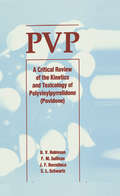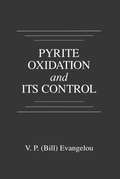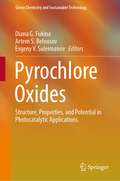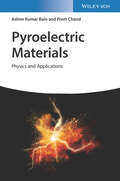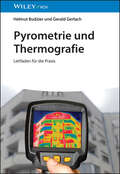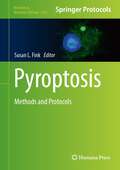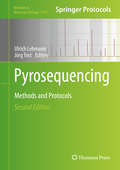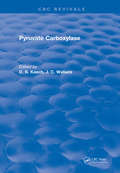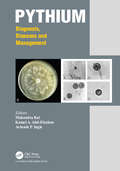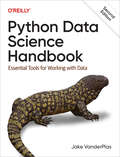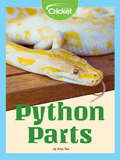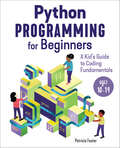- Table View
- List View
Pushing the Limits: New Adventures in Engineering
by Henry PetroskiHere are two dozen tales in the grand adventure of engineering from the Henry Petroski, who has been called America's poet laureate of technology. Pushing the Limits celebrates some of the largest things we have created-bridges, dams, buildings--and provides a startling new vision of engineering's past, its present, and its future. Along the way it highlights our greatest successes, like London's Tower Bridge; our most ambitious projects, like China's Three Gorges Dam; our most embarrassing moments, like the wobbly Millennium Bridge in London; and our greatest failures, like the collapse of the twin towers on September 11. Throughout, Petroski provides fascinating and provocative insights into the world of technology with his trademark erudition and enthusiasm for the subject.
Put On Your Owl Eyes: Open Your Senses & Discover Nature's Secrets; Mapping, Tracking & Journaling Activities
by Devin FranklinChildren will see the natural world around them with brand new eyes, as they learn to follow its signs, hear its language, and understand its secrets. With this unique and compelling book written by expert environmental educator Devin Franklin, kids aged 8 to 13 will build their own relationship with nature through finding a “Sit Spot” — an outdoor space in the backyard, in a field or in the woods, in a vacant lot or a city park — where they can stop, observe, and become familiar with the flora and fauna that live there. From the Six Arts of Tracking (Who, What, Where, When, Why, and How) and making a habitat map to walking in smooth silence like a fox and learning the basics of bird language, exploration exercises lead young readers on a fascinating journey of discovery as they watch, listen, map, interpret, and write about the sounds, sights, scents, and patterns they encounter. With journaling prompts, map-making activities, and observational tracking practice throughout, Put On Your Owl Eyes is an interactive and thought-provoking guidebook. This publication conforms to the EPUB Accessibility specification at WCAG 2.0 Level AA.
Putting Inequality in Context: Class, Public Opinion, and Representation in the United States
by Christopher EllisRising income inequality is highlighted as one of the largest challenges facing the United States, affecting civic participation and political representation. Although the wealthy often can and do exert more political influence, this is not always the case. To fix political inequality, it is important to understand exactly how class divisions manifest themselves in political outcomes, and what factors serve to enhance, or depress, inequalities in political voice. Christopher Ellis argues citizens’—and legislators’—views of class politics are driven by lived experience in particular communities. While some experience is formally political, on an informal basis citizens learn a great deal about their position in the broader socioeconomic spectrum and the social norms governing how class intersects with day-to-day life. These factors are important for policymakers, since most legislators do not represent “the public” at large, but specific constituencies. Focusing on U.S. congressional districts as the contextual unit of interest, Ellis argues individuals’ political behavior cannot be separated from their environment, and shows how income’s role in political processes is affected by the contexts in which citizens and legislators interact. Political inequality exists in the aggregate, but it does not exist everywhere. It is, rather, a function of specific arrangements that depress the political influence of the poor. Identifying and understanding these factors is a crucial step in thinking about what reforms might be especially helpful in enhancing equality of political voice.
Putting Information First: Luciano Floridi and the Philosophy of Information (Metaphilosophy Ser. #16)
by Patrick AlloPutting Information First focuses on Luciano Floridi’s contributions to the philosophy of information. Respected scholars stimulate the debate on the most distinctive and controversial views he defended, and present the philosophy of information as a specific way of doing philosophy. Contains eight essays by leading scholars, a reply by Luciano Floridi, and an epilogue by Terrell W. Bynum Explains the importance of philosophy of information as a specific way of doing philosophy Focuses directly on the work of Luciano Floridi in the area of philosophy of information, but also connects to contemporary concerns in philosophy more generally Illustrates several debates that arise from core themes in the philosophy of information
Putting Ourselves Back in the Equation: Why Physicists Are Studying Human Consciousness and AI to Unravel the Mysteries of the Universe
by George MusserDistant galaxies, dark matter, black holes – elusive, incomprehensible and inhospitable – these are the building blocks of modern physics. But where do we fit in this picture? For centuries, we have separated mind from matter. While physicists have pursued a theory of &‘everything&’ with single-minded purpose, the matter of the mind, of human consciousness, has been conveniently sidestepped and ignored – consigned to priests, philosophers and poets. With the ambition of Stephen Hawking, Carlo Rovelli and Brian Cox, Putting Ourselves Back in the Equation sets out a bold new vision for theoretical physics, unrestricted by sleek equations and neat formulations. Combining cutting-edge neuroscience with the latest in quantum mechanics, acclaimed writer Musser offers a new interpretation of human consciousness. From bizarre cognitive phenomena, like lucid dreaming and self-taught synaesthesia, to the latest technological developments in AI, Musser asks: what can physics teach us about what it means to be human?
Putting Ourselves Back in the Equation: Why Physicists Are Studying Human Consciousness and AI to Unravel the Mysteries of the Universe
by George Musser“This is a delightful account of one of the deepest and most fascinating explorations going on today at the frontier of our knowledge.” —Carlo Rovelli, bestselling author of The Order of Time and Seven Brief Lessons on Physics“Musser knows that the point of popular science is [. . .] to get a sense of what’s at stake, what kinds of answers are being offered to difficult questions, and why it all matters. One could not ask more of Putting Ourselves Back in the Equation—on all three counts it delivers.” —Julian Baggini, The Wall Street JournalA revelatory exploration of how a “theory of everything” depends upon our understanding of the human mind.The whole goal of physics is to explain what we observe. For centuries, physicists believed that observations yielded faithful representations of what is out there. But when they began to study the subatomic realm, they found that observation often interferes with what is being observed—that the act of seeing changes what we see. The same is true of cosmology: our view of the universe is inevitably distorted by observation bias. And so whether they’re studying subatomic particles or galaxies, physicists must first explain consciousness—and for that they must turn to neuroscientists and philosophers of mind.Neuroscientists have painstakingly built up an understanding of the structure of the brain. Could this help physicists understand the levels of self-organization they observe in other systems? These same physicists, meanwhile, are trying to explain how particles organize themselves into the objects around us. Could their discoveries help explain how neurons produce our conscious experience?Exploring these questions and more, George Musser tackles the extraordinary interconnections between quantum mechanics, cosmology, human consciousness, and artificial intelligence. Combining vivid descriptive writing with portraits of scientists working on the cutting edge, Putting Ourselves Back in the Equation shows how theories of everything depend on theories of mind—and how they might be one and the same.
Putting Pharmacokinetics and Pharmacodynamics to Work in Drug Discovery: A Practical Guide for Pharmaceutical Scientists
by Emile P. ChenDevelop drugs with a greater understanding of their bodily impact Pharmaceutical scientists in the fields of pharmacokinetics and pharmacodynamics study how drugs behave in the body and how they reach their site of action to exert their intended pharmacological activities. Drug discovery stands to benefit enormously from the timely application of pharmacokinetics and pharmacodynamics in order to make informed decisions and solve practical problems. Putting Pharmacokinetics and Pharmacodynamics to Work in Drug Discovery bridge between scientific concepts and practical industrial practice by bringing these principles to bear on every stage of the drug discovery process. Beginning with target identification and moving through each subsequent decision point including high throughput screening, hit-to-lead, lead optimization and candidate selection. The book offers a comprehensive guide to minimizing attrition, reducing costs, and more. The result is an invaluable tool in developing smarter and more effective drug discovery processes. Putting Pharmacokinetics and Pharmacodynamics to Work in Drug Discovery readers will also find: A work designed to make scientific principles accessible to pharmaceutical scientists in diverse areas, not just pharmacokinetists or DMPK scientists Industrial examples, both positive and negative, showing pharmacokinetic and pharmacodynamic principles at work Interactive exercises at the end of each section to encourage holistic and integrated thinking Putting Pharmacokinetics and Pharmacodynamics to Work in Drug Discovery is ideal for any researchers or professionals involved in drug discovery and development, including medicinal chemists, biopharmaceutics scientists, clinicians, project leaders, and many others.
Putting Responsible Research and Innovation into Practice: A Multi-Stakeholder Approach (Library of Ethics and Applied Philosophy #40)
by Vincent BlokThis Open Access book builds on the experiences of one of the largest European projects in the domain of responsible Research and Innovation: NewHoRRIzon. It highlights the potential of and opportunity in responsible R&I to conduct innovation in a socially responsible way. Employing the methodology of Social Labs, the book analyses responsible R&I from an experience-based viewpoint and further explores the application of responsible R&I beyond scholarly and industrial interests. The contributors analyze the current European R&I landscape, provide reflection and reconceptualization of its core concepts, and project future challenges in relation to responsible R&I. The book complements the readers' line of work by providing insights on how responsible R&I can be applied by the audience, for example, in their decision-making processes.
Putting Social Media and Networking Data in Practice for Education, Planning, Prediction and Recommendation (Lecture Notes in Social Networks)
by Jalal Kawash Reda Alhajj Mehmet Kaya Şuayip BirinciThis book focusses on recommendation, behavior, and anomaly, among of social media analysis. First, recommendation is vital for a variety of applications to narrow down the search space and to better guide people towards educated and personalized alternatives. In this context, the book covers supporting students, food venue, friend and paper recommendation to demonstrate the power of social media data analysis. Secondly, this book treats behavior analysis and understanding as important for a variety of applications, including inspiring behavior from discussion platforms, determining user choices, detecting following patterns, crowd behavior modeling for emergency evacuation, tracking community structure, etc. Third, fraud and anomaly detection have been well tackled based on social media analysis. This has is illustrated in this book by identifying anomalous nodes in a network, chasing undetected fraud processes, discovering hidden knowledge, detecting clickbait, etc. With this wide coverage, the book forms a good source for practitioners and researchers, including instructors and students.
Pvp: A Critical Review of the Kinetics and Toxicology of Polyvinylpyrrolidone (Povidone)
by Wolfgang SchwarzPolyvinylpyrrolidone is widely used in medicine, pharmaceuticals, cosmetics, foods, printing inks, textiles, and many more diverse applications. This book describes the 50 years of research, published and unpublished, on the absorption, distribution, storage, and excretion of PVP. The toxicology of PVP is critically evaluated. The author's involvement in the recent reevaluation of PVP by the Joint Expert Committee on Food Additives of the World Health Organization (WHO) and the Food and Agriculture Organization (FOA) led them to undertake this comprehensive review of all the information on the subject. This book will be invaluable for anyone who is involved with polyvinylpyrrolidone. Included is a broad review of the toxicological studies performed on PVP, including acute, subchronic, chronic, reproductive, mutagenicity, and carcinogenicity studies. There is also an appendix listing the key studies, with references, on the absorption, renal elimination, distribution, acute toxicity, subchronic toxicity, chronic toxicity, teratogenicity, mutagenicity, and carcinogenicity of PVP.
Pyrethroid Insecticides (The Handbook of Environmental Chemistry #92)
by Ethel EljarratThis book reviews the latest developments concerning the analysis, fate, behaviour and toxicity of pyrethroid insecticides. Over the last few decades, pyrethroid insecticides have increasingly replaced organochlorine pesticides due to their relatively lower mammalian toxicity, selective insecticide activity and lower environmental persistence. They represent 25% of global sales of insecticides, and are considered to be “safe” since they are converted to non-toxic metabolites by oxidative metabolism in fish and by hydrolysis in mammals. However, recent studies have demonstrated their environmental ubiquity, their bioaccumulation and their toxicity in various aquatic and terrestrial organisms, and even in humans. Featuring contributions by leading experts, the book discusses the physico-chemical properties and uses of pyrethroid insecticides; the latest chemical analytical methods; their occurrence in the environment, biota and food; and their isomeric and enantiomeric behaviour. It particularly highlights the toxicological effects and human exposure to pyrethroid insecticides, and also offers insights into the effects of the salmon industry on the marine environment with a case study of sea lice treatment using pyrethroids. This comprehensive book is a valuable source of information for environmental scientists, policymakers and producers interested in issues related to pyrethroid insecticides.
Pyrethroids
by Tatsuya Mori Noritada MatsuoProgress and Future of Pyrethroids, by Yoshio Katsuda Pyrethrin Biosynthesis and Its Regulation in Chrysanthemum cinerariaefolium, by Kazuhiko Matsuda Recent Advances of Pyrethroids for Household Use, by Kazuya Ujihara, Tatsuya Mori and Noritada Matsuo The Biological Activity of a Novel Pyrethroid: Metofluthrin, by Masayo Sugano and Takao Ishiwatari Advances in the Mode of Action of Pyrethroids, J. Marshall Clark and Steven B. Symington Mammal Toxicology of Synthetic Pyrethroids, by Ryozo Tsuji, Tomoya Yamada and Satoshi Kawamura Biotransformation and Enzymatic Reactions of Synthetic Pyrethroids in Mammals, by Kazuki Mikata, Naohiko Isobe and Hideo Kaneko Environmental Behavior of Synthetic Pyrethroids, by Toshiyuki Katagi Ecotoxicology of Synthetic Pyrethroids, by S. J. Maund, P. J. Campbell, J. M. Giddings, M. J. Hamer, K. Henry, E. D. Pilling, J. S. Warinton and J. R. Wheeler
Pyrite Oxidation and Its Control
by V. P. EvangelouPyrite Oxidation and its Control is the single available text on the market that presents the latest findings on pyrite oxidation and acid mine drainage (AMD). This new information is an indispensable reference for generating new concepts and technologies for controlling pyrite oxidation.This book focuses on pyrite oxidation theory, experimental findings on oxidation mechanisms, as well as applications and limitations of amelioration technologies. The text also includes discussions on the theory and potential application of novel pyrite microencapsulation technologies for controlling pyrite oxidation currently under investigation in the author's laboratory.
Pyrochlore Oxides: Structure, Properties, and Potential in Photocatalytic Applications (Green Chemistry and Sustainable Technology)
by Diana G. Fukina Artem S. Belousov Evgeny V. SuleimanovThis book presents an in-depth exploration of complex metal oxides, focusing on their applications in photocatalysis and biomedical materials. It highlights the practical importance of complex metal oxides, which have gained significant attention in recent years due to their diverse range of properties. The book specifically delves into the most representative series of compounds based on stable structural types of minerals, such as perovskite, fluorite, pyrochlore, corundum, and rutile. It also emphasizes the scientific interest in the pyrochlore mineral structure, which has been shown to exhibit photocatalytic activity.Recent studies have revealed that some compounds with the pyrochlore structure can act as promising candidates for photocatalysis. Additionally, the book highlights the use of photocatalysis in producing biomedical materials based on natural polymers. These materials possess a unique combination of components assembled in a specific structure, which makes them highly attractive for regenerative medicine associated with cell/tissue regeneration stimulation. Overall, this book offers a comprehensive analysis of the potential of complex metal oxides, particularly those with the pyrochlore structure, and is particularly useful for those researchers working in the fields of green chemistry and biomedical materials science.
Pyroelectric Materials: Physics and Applications
by Ashim Kumar Bain Prem ChandPyroelectric Materials An authoritative and practical discussion of pyroelectric materials and their applications In Pyroelectric Materials: Physics and Applications, the authors deliver a comprehensive exploration of the physics of pyroelectric materials and their applications. With authoritative coverage of a wide variety of critical topics in the field, the authors provide the readers with chapters on dielectric fundamentals, pyroelectricity, pyroelectric materials and their applications such as pyroelectric infrared detectors, pyroelectric energy harvesting, and pyroelectric fusion. Readers will also find: A thorough introduction to the fundamentals of dielectrics, including discussions of polarization, dispersion, relaxation, and the molecular theory of induced charges in a dielectric Comprehensive explorations of pyroelectricity, including its history, theory, and a simple model of pyroelectric effect Perfect for researchers and professionals with an interest in pyroelectric materials, the book is also useful for graduate students taking courses involving pyroelectric materials and their applications.
Pyrometrie und Thermografie: Leitfaden für die Praxis
by Gerald Gerlach Helmut BudzierPyrometrie und Thermografie Die Thermografie ist ein bildgebendes Verfahren, um Oberflächentemperaturen von Objekten anzuzeigen. Dies erfolgt, indem man die Intensität der Infrarotstrahlung, die von einem bestimmten Punkt ausgeht, misst und daraus die dort herrschende Temperatur berechnet. Als Messgeräte dazu werden Thermografie-Kameras verwendet. Wird die Temperatur nur an einem Punkt gemessen, spricht man von Pyrometrie, die entsprechenden Geräte werden als Pyrometer bezeichnet. Die berührungslose Temperaturmessung ist überall dort von großem Interesse, wo hohe Temperaturen auftreten, harsche Bedingungen herrschen oder der Messort nicht erreicht werden kann. Das ist zum Beispiel in der Prozessmesstechnik, in Gießereien und Stahlwerken oder der Überwachung von brandanfälligen Umgebungen (Wälder, Müllplätze) der Fall. Das Buch wendet sich an alle, die Pyrometer und Thermografie-Kameras nutzen und typischerweise mit den zu überwachenden Prozessen vertraut sind, aber oft nicht mit der einzusetzenden Messtechnik. Deshalb fokussiert es auf die Anwendung von Pyrometern und Thermografie-Kameras und macht auf übersichtliche Weise mit den Grundlagen, den Fehlereinflüssen, den Grenzen hinsichtlich der thermischen, zeitlichen und räumlichen Auflösung und der erreichbaren Messgenauigkeit vertraut.
Pyroptosis: Methods and Protocols (Methods in Molecular Biology #2641)
by Susan L. FinkThis volume explores techniques used to study and understand the latest research on pyroptosis. The chapters in this book cover topics such as experimental methods to induce pyroptosis via inflammasomes; approaches to identifying inflammasome activation in humans; ways to induce and detect pore formation; and techniques to evaluate cellular outcomes of pyroptotic cell death. Written in the highly successful Methods in Molecular Biology series format, chapters include introductions to their respective topics, lists of the necessary materials and reagents, step-by-step, readily reproducible laboratory protocols, and tips on troubleshooting and avoiding known pitfalls.Cutting-edge and thorough, Pyroptosis: Methods and Protocols is a valuable tool for researchers who want to expand their knowledge of this developing field. It will be especially beneficial for those working in the fields of immunology, cancer biology, microbiology, and cell biology.
Pyrosequencing
by Jörg Tost Ulrich LehmannThe primary purpose of this volume is to demonstrate the range of applications of the Pyrosequencing technology in research and diagnostics and to provide detailed protocols. Beginning with an up-to-date overview of the biochemistry, the volume continues with quantitative analysis of genetic variation, ratio of expressed alleles at the RNA level, analysis of DNA methylation, global DNA methylation assays, specialized applications for DNA methylation analysis including loss of imprinting, single blastocyst analysis, allele-specific DNA methylation patterns, DNA methylation patterns associated with specific histone modifications. The volume further details tools and protocols for the detection of viruses and bacteria, and genetic and epigenetic analyses for forensics using Pyrosequencing. As a volume in the highly successful Methods in Molecular Biology series, chapters contain introductions to their respective topics, lists of the necessary materials and reagents, step-by-step, readily reproducible protocols and tips on troubleshooting and avoiding known pitfalls. Comprehensive and adaptable, Pyrosequencing: Methods and Protocols, Second Edition will greatly aid doctorial students, postdoctoral investigators and research scientists studying different aspects of genetics and cellular and molecular biology.
Pyrrhic Progress: The History of Antibiotics in Anglo-American Food Production (Critical Issues in Health and Medicine)
by Claas KirchhellePyrrhic Progress analyses over half a century of antibiotic use, regulation, and resistance in US and British food production. Mass-introduced after 1945, antibiotics helped revolutionize post-war agriculture. Food producers used antibiotics to prevent and treat disease, protect plants, preserve food, and promote animals’ growth. Many soon became dependent on routine antibiotic use to sustain and increase production. The resulting growth of antibiotic infrastructures came at a price. Critics blamed antibiotics for leaving dangerous residues in food, enabling bad animal welfare, and selecting for antimicrobial resistance (AMR) in bacteria, which could no longer be treated with antibiotics. Pyrrhic Progress reconstructs the complicated negotiations that accompanied this process of risk prioritization between consumers, farmers, and regulators on both sides of the Atlantic. Unsurprisingly, solutions differed: while Europeans implemented precautionary antibiotic restrictions to curb AMR, consumer concerns and cost-benefit assessments made US regulators focus on curbing drug residues in food. The result was a growing divergence of antibiotic stewardship and a rise of AMR. Kirchhelle’s comprehensive analysis of evolving non-human antibiotic use and the historical complexities of antibiotic stewardship provides important insights for current debates on the global burden of AMR.
Pyruvate Carboxylase
by KeechThis book is a welcome source of information on this enzyme which is vitally important to many forms of life. Each chapter or section of each volume is not written primarily for those specializing in that narrow area, but rather to provide a coherent and integrated summary of that aspect got those working on other, quite different facets of the same enzyme.
Pythium: Diagnosis, Diseases and Management
by Mahendra Rai Avinash P. Ingle Kamel A. Abd-ElsalamPythium is one of the most important phytopathogens causing significant damage to agriculture, forest, and nurseries, etc. It is an unseen enemy of the root zone of various plants and hence considered as "hidden terror" for a number of plants. An accurate diagnosis and identification of Pythium causing various infections in plants is very important because it is often confused with several other fungi. Pythium infections are difficult to control once they have set in. Therefore, its effective and ecofriendly management is of paramount importance. In addition, there are many reports on Pythium causing infections in human beings and animals. The present book on Pythium focuses on various aspects which mainly include pathogenesis, technological developments in detection and diagnosis, and its management. Key Features Includes identification of Pythium spp. by traditional and molecular methods Deals with different diseases caused by Pythium spp Describes the role of Pythium in mammalian diseases Incorporates various management strategies Discusses emerging role of nanotechnological tools for the management of Pythium diseases
Python Data Science Handbook: Essential Tools for Working with Data
by Jake VanderPlasPython is a first-class tool for many researchers, primarily because of its libraries for storing, manipulating, and gaining insight from data. Several resources exist for individual pieces of this data science stack, but only with the new edition of Python Data Science Handbook do you get them all--IPython, NumPy, pandas, Matplotlib, scikit-learn, and other related tools.Working scientists and data crunchers familiar with reading and writing Python code will find the second edition of this comprehensive desk reference ideal for tackling day-to-day issues: manipulating, transforming, and cleaning data; visualizing different types of data; and using data to build statistical or machine learning models. Quite simply, this is the must-have reference for scientific computing in Python.With this handbook, you'll learn how:IPython and Jupyter provide computational environments for scientists using PythonNumPy includes the ndarray for efficient storage and manipulation of dense data arraysPandas contains the DataFrame for efficient storage and manipulation of labeled/columnar dataMatplotlib includes capabilities for a flexible range of data visualizationsScikit-learn helps you build efficient and clean Python implementations of the most important and established machine learning algorithms
Python Experiments in Physics and Astronomy
by Padraig HoulahanPython Experiments in Physics and Astronomy acts as a resource for science and engineering students or faculty who would like to see how a diverse selection of topics can be analyzed and simulated using Python programs. The book also provides Python solutions that can be learned from and modified as needed. The book is mainly aimed at undergraduates, but since many science students and faculty have limited exposure to scientific programming, having a collection of examples that address curve-fitting, Fast Fourier Transforms, image photometry and image alignment, and many others could be very helpful not just for learning from, but also to support classroom projects and demonstrations.Key Features: Features tutorials using Python for non-computer science students and faculty involved with scientific programming Contains complete scientific programming examples for teaching and academic projects Presents detailed Python solutions for Physics and Astronomy topics, not normally covered in depth, because they would be too time-consuming
Python Parts
by Amy TaoSlither into the scaly world of the mighty python! Learn about all the parts that make the python such a strange and misunderstood creature. See how its anatomy allows it to be more than just a limbless tube-like animal! Gain knowledge about this reptile’s habits and senses.
Python Programming for Beginners: A Kid's Guode to Coding Fundamentals
by Patricia FosterThink like a programmer with this fun beginner's guide to Python for ages 10 to 14Kids can learn to code with the power of Python! Python Programming for Beginners is the perfect way to introduce aspiring coders to this simple and powerful coding language. This book teaches kids all about Python and programming fundamentals—and is packed full of fun and creative activities that make learning a blast!In Python Programming for Beginners, kids will start off with the basics, learning all about fundamental coding concepts and how they can put these concepts together in Python to build their own games and programs. Each chapter focuses on a different coding concept—like variables, data types, and loops—and features three awesome coding activities to try. These activities get more difficult as they go, so young coders can see just how much their skills are growing. By the end of Python Programming for Beginners, they'll create their own fully functional sci-fi game and crack the code to a secret message!Python Programming for Beginners features:No coding experience needed!—Designed just for kids, this Python programming book is filled with step-by-step directions, simple explanations, and detailed code breakdowns.Build a coding toolbox—Kids will build their programming skills, learn how to troubleshoot bugs with a handy bug-hunting guide, and practice their Python programming knowledge with cool activities.Why Python programming?—Python is an awesome starting language for kids! It's a powerful programming language that can be used for lots of projects but features simple syntax so beginners can focus on learning programming logic.Set kids up for a lifetime of programming success with Python Programming for Beginners .









